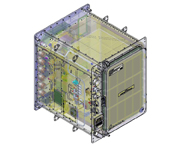March 16, 2009
 |
| GLACIER Freezer. Download image. |
BIRMINGHAM, Ala. - The newest generation of compact research freezers is performing well in space and have already boosted the scientific capacity of the International Space Station (ISS), said engineers at the University of Alabama at Birmingham (UAB).
A UAB-designed cryogenic freezer called GLACIER, short for General Laboratory Active Cryogenic ISS Experiment Refrigerator, made its NASA debut in late 2008 aboard a shuttle flight to the station.
This month's flight of space shuttle Discovery marks another milestone for GLACIER as the first freezer is re-packed onto the shuttle for return to Earth. It is filled with frozen blood samples, cell cultures and other experiments.
From a satellite-linked control center in Birmingham, engineers at UAB's Center for Biophysical Sciences and Engineering recently sent the first 'start-up' signals to the ISS to begin cooling down GLACIER. It took more than six hours to reach the target temperature of minus 95 degrees Celsius, said UAB project coordinator Josh Dunn.
Just as the first GLACIER returns with its science cargo, a second freezer will be installed in its place on the ISS and prepped for more research samples. The freezers are part of a National Aeronautics and Space Administration contract awarded to the UAB biophysical center in 2005.